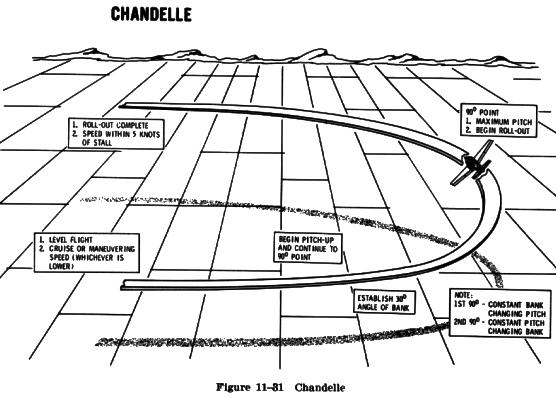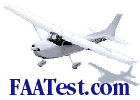| Chandelles
A "chandelle" is a climbing turn beginning from approximately straight and level flight, and ending at the completion of 180 degrees of turn in a wings level, nose high attitude at the minimum controllable airspeed (Fig. 11-31). The maneuver demands that the maximum flight performance of the airplane be obtained; that is, the airplane should gain the most altitude possible for a given degree of bank and power setting without stalling. However, since numerous atmospheric variables beyond control of the pilot will affect the specific amount of altitude gained, the altitude gain is not a criterion of the quality of the maneuver. 
The objective of this maneuver is to develop the pilot's
coordination, orientation, planning, and feel for maximum performance flight,
and to develop positive control techniques at varying airspeeds and attitudes.
After the appropriate airspeed and power setting have been established, the chandelle is started by smoothly entering a coordinated turn with an angle of bank appropriate for the airplane being flown. Normally, this angle of bank should not exceed approximately 30 degrees. After the appropriate bank is established, a climbing turn should be started by smoothly applying back elevator pressure to increase the pitch attitude at a constant rate and to attain the highest pitch attitude as 90 degrees of turn is completed. As the climb is initiated in airplanes with fixed pitch propellers, full throttle may be applied but must be applied gradually so that the maximum allowable RPM is not exceeded. In airplanes with constant speed propellers, power may be left at the normal cruise setting. (Prior to starting the maneuver, RPM may be increased to climb or takeoff setting and then throttle increased as the climb is started.) Once the bank ha been established, the angle of bank should remain constant until 90 degrees of turn is completed. Although the degree of bank is fixed during this climbing turn, it may appear to increase and, in fact, actually will tend to increase if allowed to do so as the maneuver continues. When the turn has progressed 90 degrees from the original heading, the pilot should begin rolling out of the bank at a constant rate while maintaining a constant pitch attitude. Since the angle of bank will be decreasing during the rollout, the vertical component of lift will increase slightly. For this reason, it may be necessary to release a slight amount of back elevator pressure in order to keep the nose of the airplane form rising higher. As the wings are being leveled at the completion of 180 degrees of turn, the pitch attitude should be noted by checking the outside references and the attitude indicator. This pitch attitude should be held momentarily while the airplane is at the minimum controllable airspeed. Then the pitch attitude may be gently reduced to return to straight and level cruise flight. Since the airspeed is constantly decreasing throughout the maneuver, the effects of engine torque become more and more prominent. Therefore, right rudder pressure must be gradually increased to control yaw and maintain a constant rate of turn and to keep the airplane in coordinated flight. The pilot should maintain coordinated flight by the "feel" of pressures being applied on the controls, and by the ball instrument of the turn and slip indicator. If coordinated flight is being maintained, the ball will remain in the center of the race. To roll out of a left chandelle, the left aileron must be lowered to raise the left wing. This creates more drag than the aileron on the right wing, resulting in a tendency for the airplane to yaw to the left. With the low airspeed at this point, torque effect tries to make the airplane yaw to the left even more. Thus, there are two forces pulling the airplane's nose to the left - aileron drag and torque. To maintain coordinated flight, considerable right rudder pressure must be used during the rollout to overcome the effects of aileron drag and torque. In a chandelle to the right, when control pressure is applied to begin the rollout, the aileron on the right wing is lowered. This creates more drag on that wing and tends to make the airplane yaw to the right. At the same time, however, the effect of torque at the lower airspeed is causing the airplane's nose to yaw to the left. Thus, aileron drag pulling the nose to the right and torque pulling to the left, tend to neutralize each other. If excessive left rudder pressure is applied, the rollout will be uncoordinated. The rollout to the left can usually be accomplished with very little left rudder, since the effects of aileron drag and torque tend to neutralize each other. Releasing some right rudder, which has been applied to correct for torque, will normally give the same effect as applying left rudder pressure. When the wings become level and the ailerons are neutralized, the aileron drag disappears. At this time, however, because of the low airspeed and high power, the effects of torque become the more prominent force and must continue to be controlled with rudder pressure. A rollout to the left, therefore, is accomplished mainly by
applying aileron pressure. During the rollout, right rudder pressure should be
gradually released, and left rudder applied only as necessary to maintain
coordination. Even when the wings are level and aileron pressure is released,
right rudder pressure must be held to counteract torque and hold the nose
straight.
|
